headlamp CITROEN RELAY 2015 Handbook (in English)
[x] Cancel search | Manufacturer: CITROEN, Model Year: 2015, Model line: RELAY, Model: CITROEN RELAY 2015Pages: 248, PDF Size: 8.86 MB
Page 6 of 248
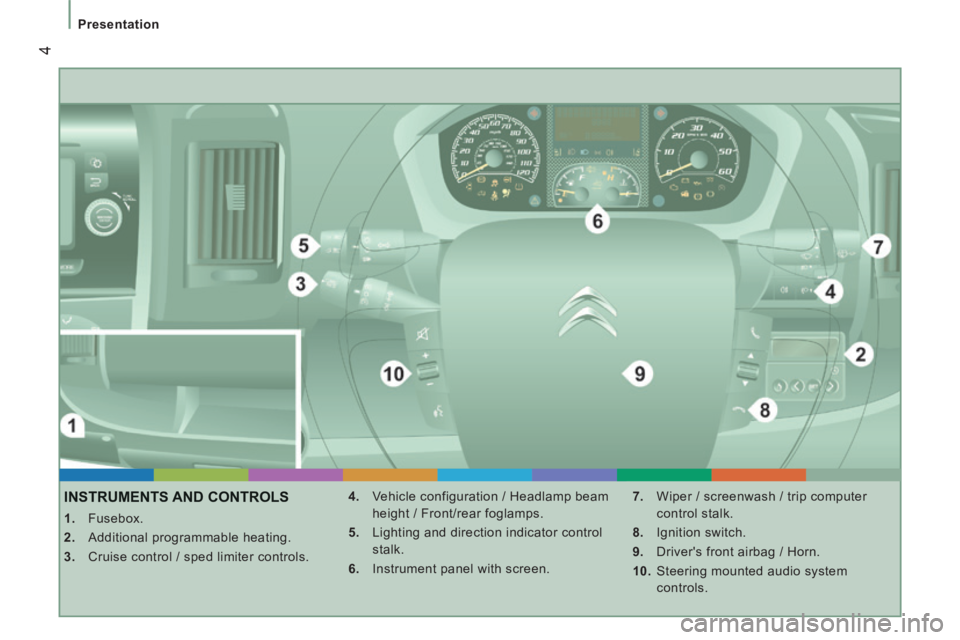
4
Presentation
INSTRUMENTS AND CONTROLS
1. Fusebox.
2. Additional programmable heating.
3. Cruise control / sped limiter controls. 4. Vehicle configuration / Headlamp beam
height / Front/rear foglamps.
5. Lighting and direction indicator control stalk.
6. Instrument panel with screen. 7. Wiper / screenwash / trip computer
control stalk.
8. Ignition switch.
9. Driver's front airbag / Horn.
10. Steering mounted audio system controls.
Page 8 of 248

6
Location
EXTERIOR
Rear lamps, direction indicators,
3 rd brake lamp,
foglamps 44, 138, 142-143
Left-hand side:
fuel fi ller cap, fuel tank
129
Fuel cut-off 130
Load space 80-81
Rear doors 21
Number plate lamp 143
Rear parking sensors 91
Spare wheel, jack, changing
a wheel, tools, puncture
repair kit 145-149
Infl ating, pressures 149, 163
Snow chains 120
Towing, lifting 150
Towbar, towball 116-118 Dimensions
152-158
Accessories 119
Roof rack, roof bars 118
Brakes, pads 124, 127
Braking assistance systems 96-97
Trajectory control 98-100
Tyres, pressures 149, 163
Pneumatic suspension 93-94 Key, remote control, battery 14-17
Starting
18, 38-39
Central locking 22
Confi dential card 18
Alarm 19
Wiper blade 144
Door mirror 82
Side repeater 141
Front lamps, direction indicators,
front foglamps 44, 138-141
Headlamp beam height adjustment 46
Headlamp wash 47
Changing bulbs 138-141
Opening/closing doors 20-22
Key 15-16
Opening the bonnet, stay 122
Autoclose 84, 87
Page 9 of 248
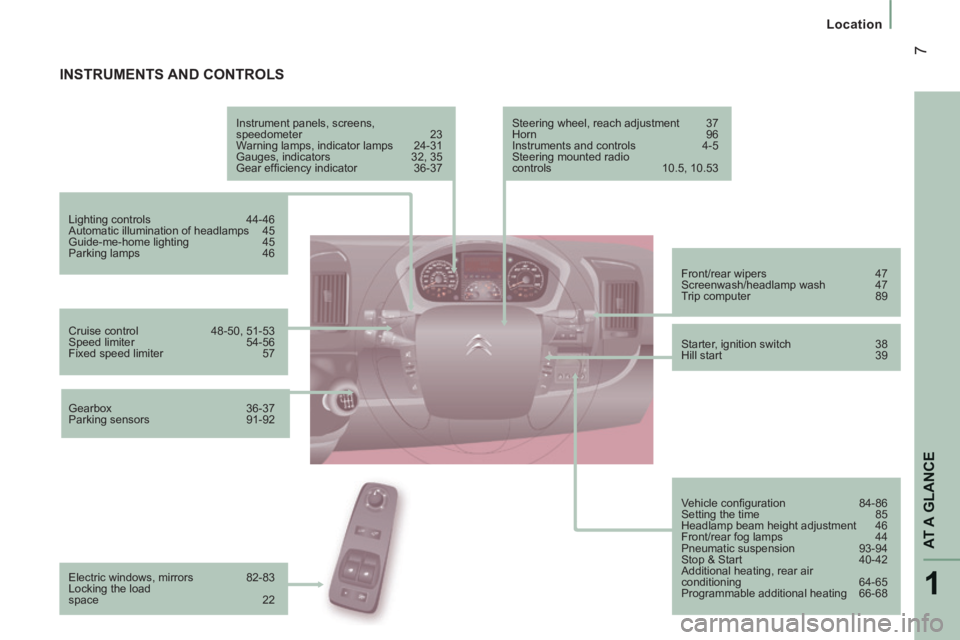
1
AT A GLANCE
7
Location
INSTRUMENTS AND CONTROLS
Instrument panels, screens,
speedometer 23
Warning lamps, indicator lamps 24-31
Gauges, indicators 32, 35
Gear effi ciency indicator 36-37
Lighting controls 44-46
Automatic illumination of headlamps 45
Guide-me-home lighting 45
Parking lamps 46
Vehicle confi guration 84-86
Setting the time 85
Headlamp beam height adjustment 46
Front/rear fog lamps 44
Pneumatic suspension 93-94
Stop & Start 40-42
Additional heating, rear air
conditioning 64-65 Programmable additional heating 66-68 Front/rear wipers 47
Screenwash/headlamp wash 47
Trip computer 89
Starter, ignition switch 38
Hill start 39
Cruise control
48-50, 51-53
Speed limiter 54-56
Fixed speed limiter 57 Steering wheel, reach adjustment 37
Horn
96
Instruments and controls 4-5
Steering mounted radio
controls 10.5, 10.53
Electric windows, mirrors 82-83
Locking the load
space 22
Gearbox
36-37
Parking sensors 91-92
Page 12 of 248
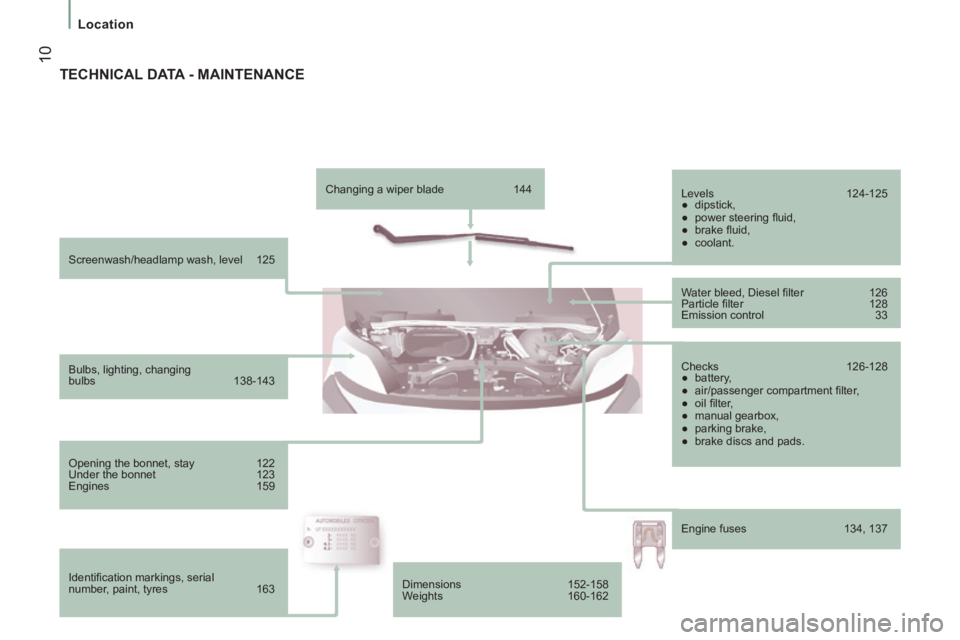
10
Location
Screenwash/headlamp wash, level 125
Bulbs, lighting, changing
bulbs 138-143
Opening the bonnet, stay 122
Under the bonnet 123
Engines 159
Identifi cation markings, serial
number, paint, tyres 163 Changing a wiper blade
144
Levels 124-125
● dipstick,
● power steering fl uid,
● brake fl uid,
● coolant.
Water bleed, Diesel fi lter 126
Particle fi lter 128
Emission control 33
Checks 126-128
● battery,
● air/passenger compartment fi lter,
● oil fi lter,
● manual gearbox,
● parking brake,
● brake discs and pads.
Engine fuses 134, 137
TECHNICAL DATA - MAINTENANCE
Dimensions 152-158
Weights 160-162
Page 14 of 248
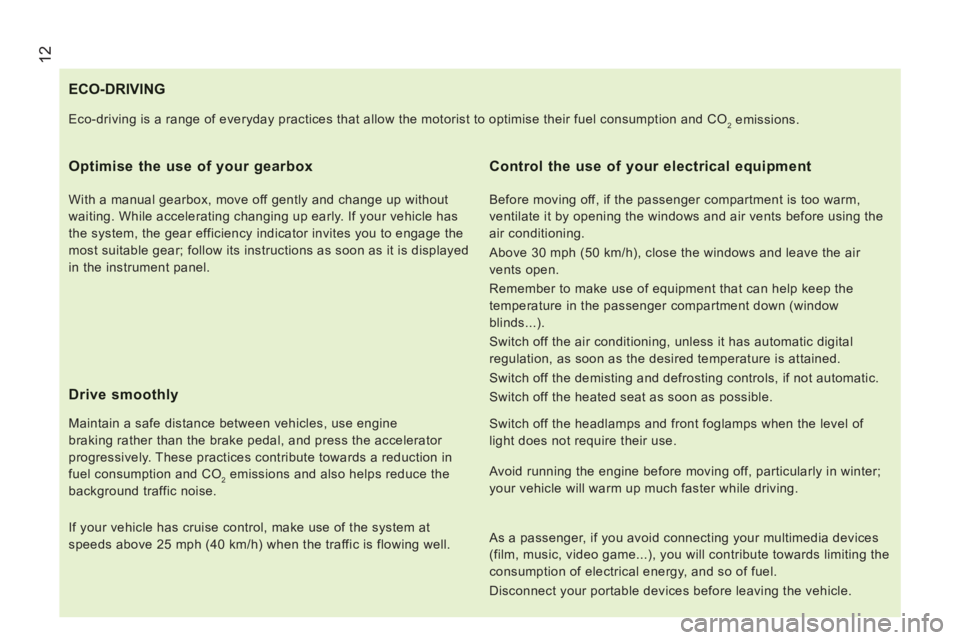
12
ECO-DRIVING
Optimise the use of your gearbox
With a manual gearbox, move off gently and change up without
waiting. While accelerating changing up early. If your vehicle has
the system, the gear efficiency indicator invites you to engage the
most suitable gear; follow its instructions as soon as it is displayed
in the instrument panel.
Drive smoothly
Maintain a safe distance between vehicles, use engine
braking rather than the brake pedal, and press the accelerator
progressively. These practices contribute towards a reduction in
fuel consumption and CO
2 emissions and also helps reduce the
background traffic noise.
If your vehicle has cruise control, make use of the system at
speeds above 25 mph (40 km/h) when the traffic is flowing well.
Control the use of your electrical equipment
Before moving off, if the passenger compartment is too warm,
ventilate it by opening the windows and air vents before using the
air conditioning.
Above 30 mph (50 km/h), close the windows and leave the air
vents open.
Remember to make use of equipment that can help keep the
temperature in the passenger compartment down (window
blinds...).
Switch off the air conditioning, unless it has automatic digital
regulation, as soon as the desired temperature is attained.
Switch off the demisting and defrosting controls, if not automatic.
Switch off the heated seat as soon as possible.
Switch off the headlamps and front foglamps when the level of
light does not require their use.
Eco-driving is a range of everyday practices that allow the motorist to \
optimise their fuel consumption and CO
2 emissions.
Avoid running the engine before moving off, particularly in winter;
your vehicle will warm up much faster while driving.
As a passenger, if you avoid connecting your multimedia devices
(film, music, video game...), you will contribute towards limiting the\
consumption of electrical energy, and so of fuel.
Disconnect your portable devices before leaving the vehicle.
Page 25 of 248
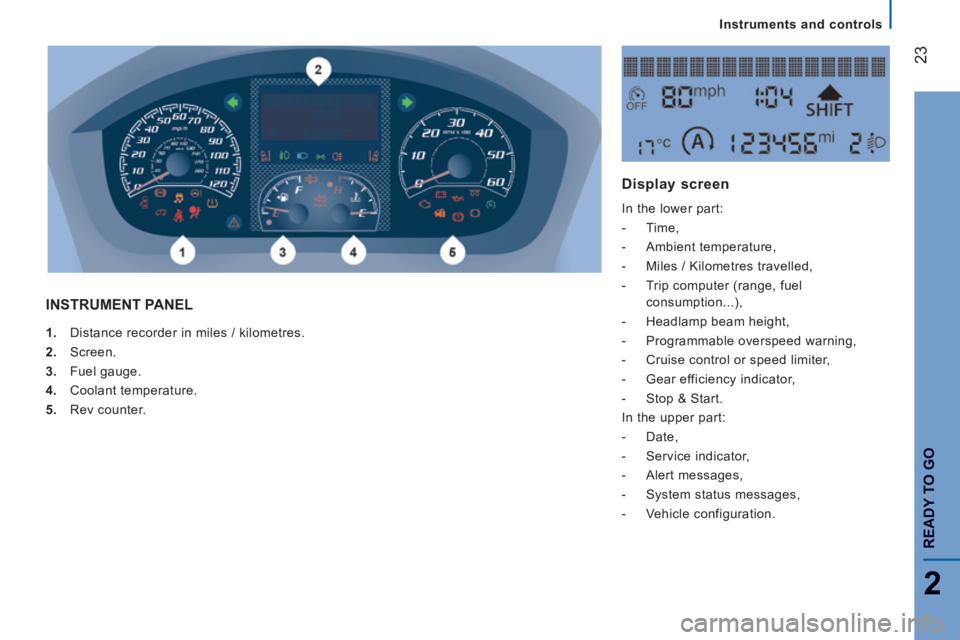
23
2
READY TO GO
Instruments and controls
1. Distance recorder in miles / kilometres.
2. Screen.
3. Fuel gauge.
4. Coolant temperature.
5. Rev counter.
INSTRUMENT PANEL
Display screen
In the lower part:
- Time,
- Ambient temperature,
- Miles / Kilometres travelled,
- Trip computer (range, fuel consumption...),
- Headlamp beam height,
- Programmable overspeed warning,
- Cruise control or speed limiter,
- Gear efficiency indicator,
- Stop & Start.
In the upper part:
- Date,
- Service indicator,
- Alert messages,
- System status messages,
- Vehicle configuration.
Page 31 of 248
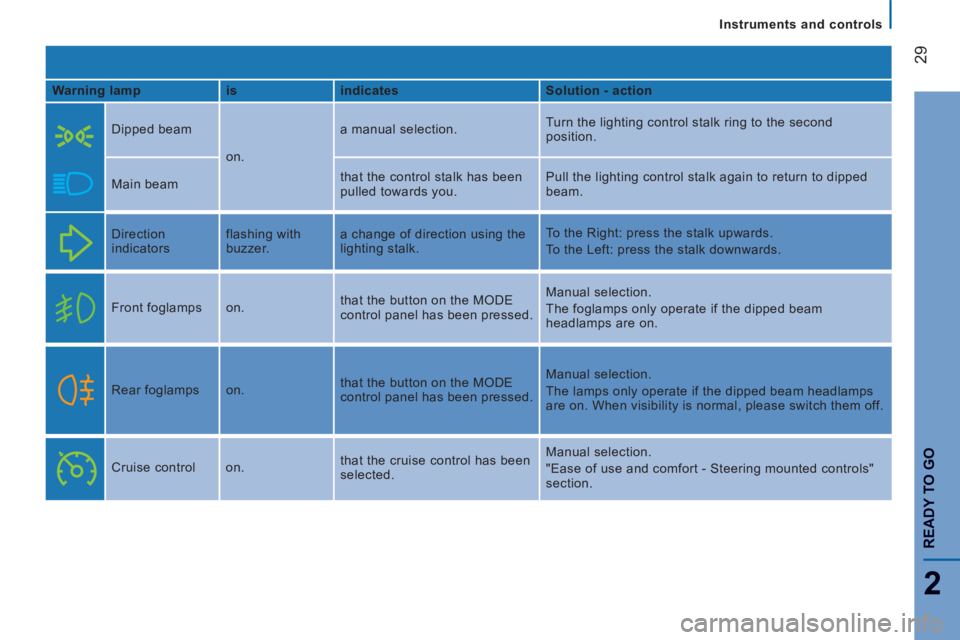
29
2
READY TO GO
Instruments and controls
Warning lamp is indicates Solution - action
Dipped beam
on. a manual selection.
Turn the lighting control stalk ring to the second
position.
Main beam that the control stalk has been
pulled towards you. Pull the lighting control stalk again to return to dipped
beam.
Direction
indicators flashing with
buzzer. a change of direction using the
lighting stalk. To the Right: press the stalk upwards.
To the Left: press the stalk downwards.
Front foglamps on. that the button on the MODE
control panel has been pressed. Manual selection.
The foglamps only operate if the dipped beam
headlamps are on.
Rear foglamps on. that the button on the MODE
control panel has been pressed. Manual selection.
The lamps only operate if the dipped beam headlamps
are on. When visibility is normal, please switch them off.
Cruise control on. that the cruise control has been
selected. Manual selection.
"Ease of use and comfort - Steering mounted controls"
section.
Page 32 of 248
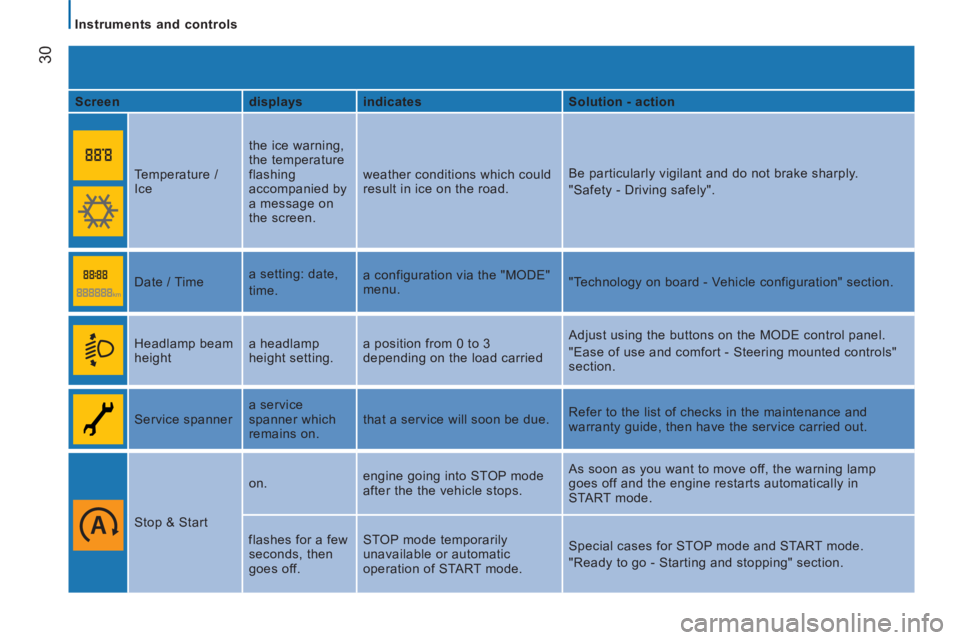
30
Instruments and controls
Screen displays indicates Solution - action
Temperature /
Ice the ice warning,
the temperature
flashing
accompanied by
a message on
the screen. weather conditions which could
result in ice on the road.
Be particularly vigilant and do not brake sharply.
"Safety - Driving safely".
Date / Time a setting: date,
time. a configuration via the "MODE"
menu.
"Technology on board - Vehicle configuration" section.
Headlamp beam
height a headlamp
height setting. a position from 0 to 3
depending on the load carried Adjust using the buttons on the MODE control panel.
"Ease of use and comfort - Steering mounted controls"
section.
Service spanner a service
spanner which
remains on. that a service will soon be due.
Refer to the list of checks in the maintenance and
warranty guide, then have the service carried out.
Stop & Start on.
engine going into STOP mode
after the the vehicle stops. As soon as you want to move off, the warning lamp
goes off and the engine restarts automatically in
START mode.
flashes for a few
seconds, then
goes off. STOP mode temporarily
unavailable or automatic
operation of START mode.
Special cases for STOP mode and START mode.
"Ready to go - Starting and stopping" section.
Page 46 of 248

44
Steering mounted controls
LIGHTING CONTROL STALK
Selection is by rotation of the white mark on
the ring.
Direction indicators (green flashing)
Left: downwards.
Right: upwards.
Sidelamps on
Dipped/main beam headlamps on
Switching between dipped and main beam
Pull the control stalk fully towards you.
Headlamp flash
Pull the control stalk towards you,
regardless of the position of the ring.
Front foglamps
Rear foglamps
If your vehicle is fitted with foglamps, these
operate with the dipped or main beam
headlamps.
Press one of these controls to switch on the
lamps. The foglamps should only be used in
fog or when snow is falling.
In clear weather or in rain, both day and
night, rear foglamps dazzle and their use is
prohibited.
Do not forget to switch them off when they
are no longer necessary. "Motorway" function
Pull the lever towards the steering wheel
with a press, without passing the point
of resistance of the lighting stalk; the
corresponding direction indicators will flash
five times.
Page 47 of 248

45
3
EASE OF USE
and
COMFORT
Steering mounted controls
AUTOMATIC ILLUMINATION
Activation
Turn the ring to this position.
Do not cover the sunshine sensor at
the top centre of the windscreen.
GUIDE-ME-HOME LIGHTING
Ignition off or key in the STOP position.
Within 2 minutes after switching off the
engine, position the ignition key in the STOP
position or remove it.
Pull the lighting stalk towards the steering
wheel.
The indicator lamp comes on in
the instrument panel.
Each action on the lighting stalk,
pulled towards the steering
wheel, prolongs the guide me home
lighting by 30 seconds up to approximately
3 minutes. When this time has elapsed, the
lamps are switched off automatically.
Deactivate this control by keeping the stalk
pulled towards the steering wheel for more
than 2 seconds. If your vehicle is fitted with this function:
when you leave your vehicle, the dipped
beam headlamps remain on for the selected
duration (when leaving a car park for
example).
You can adjust the sensitivity of the
sunshine sensor.
Refer to the "Technology on board -
Vehicle configuration" section.
If your vehicle is fitted with this function, the
dipped beam headlamps are switched on
automatically if the light is poor.
In fog or snow, the sunshine sensor may
detect sufficient light. Therefore, the lamps
will not be switched on automatically. If
necessary, you must switch on the dipped
beam headlamps manually.
They are switched off when the light returns
to a sufficient level.
LED DAYTIME RUNNING LAMPS
On starting the vehicle, in daylight the LED
daytime running lamps come on automatically.
If the sidelamps and headlamps are switched
on manually or automatically, the daytime
running lamps go off.
Programming
For countries where exterior lighting by
day is not a legal requirement, you can
activate or deactivate the function via the
configuration menu.
The lamps are switched off automatically
when the ignition is switched off.